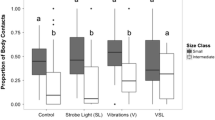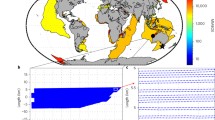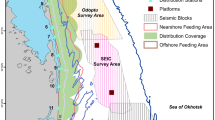Abstract
Water guns have shown the potential to repel nuisance aquatic organisms. This study examines the effects of exposure to a 1966.4 cm3 seismic water gun array (two guns) on the abundance and behavior of Bighead Carp Hypophthalmichthys nobilis, Silver Carp H. molitrix (collectively referred to as bigheaded carp) and native fishes (e.g., Smallmouth Buffalo Ictiobus bubalus). Water guns were deployed in a channel that connects the Illinois River to backwater quarry pits that contained a large transient population of bigheaded carp. To evaluate the effect of water guns, mobile side-looking split-beam hydroacoustic surveys were conducted before, during and between replicated water gun firing periods. Water guns did not affect abundance of bigheaded carp, but abundance of native fish detected during the firing treatment was 43 and 34% lower than the control and water guns off treatments, respectively. The proximity of bigheaded carp to the water gun array was similar between the water guns on and water guns off treatments. In contrast, the closest detected native fish were detected farther from the water guns during the water guns on treatment (mean ± SE, 32.38 ± 3.32 m) than during the water guns off treatment (15.04 ± 1.59 m). The water gun array had a greater impact on native fish species than on bigheaded carp. Caution should be taken to the extrapolation of these results to other fish species and to fish exposed to water guns in different environments (e.g., reduced shoreline interaction) or exposure to a larger array of water guns, or for use of water guns for purposes other than a barrier.





Similar content being viewed by others
References
Cooke SL (2015) Anticipating the spread and ecological effects of invasive bigheaded carps (Hypophthalmichthys spp.) in North America: a review of modeling and other predictive studies. Biol Invasions 18(2):315–344
Cuddington K, Currie WJS, Koops MA (2014) Could an Asian carp population establish in the Great Lakes from a small introduction? Biol Invasions 16(4):903–917
DeGrandchamp KL, Colombo RE, Garvey JE (2008) Movement and habitat selection by invasive Asian carps in a large river. Trans Am Fish Soc 137(1):45–56
Foote KG, Aglen A, Nakken O (1986) Measurement of fish target strength with a split-beam echo sounder. J Acoust Soc Am 80(2):612–621
Garvey JE, Charlebois PM, Glover D, Levengood J, Roth B, Sass GG, Secchi S, Small BC, Tripp SJ, Trushenski J, Whitledge G (2012) Fishing down the bighead and silver carps: reducing the risk of invasion to the Great Lakes. Final report to the US Fish and Wildlife Service and the Illinois Department of Natural Resources. http://asiancarp.us/documents/CARP2011.pdf. Accessed 14 Oct 2014
Gross JA, Fox JR, Irvine KM, Shields PA, Wagner TL, Wilmoth S (2013) The effects of pulse pressure from seismic water gun technology on northern pike. Trans Am Fish Soc 142(5):1335–1346
Helfman GS, Collette BB, Fancy DE (1997) The diversity of fishes. Blackwell Science, Malden
Hightower JE, Taylor JC, Degan DJ (2013) Estimating abundance of adult striped bass in reservoirs using mobile hydroacoustics. Am Fish Soc Symp 80:279–289
Hutchinson DR, Detrick RS (1984) Water gun vs air gun: a comparison. Mar Geophys Res 6(3):295–310
Kéver L, Colleye O, Herrel A, Romans P, Parmentier E (2014) Hearing capacities and otolith size in two ophidiiform species (Ophidion rochei and Carapus acus). J Exp Biol 217(14):2517–2525
Koebel CM, Egly RM (2016) Water pressure and ground vibrations induced by water guns at a backwater pond on the Illinois River near Morris, Illinois. No. 2016-5098. US Department of the Interior, US Geological Survey
Kolar C, Chapman D, Courtenay W, Housel C, Jennings D, Williams J (2005) Asian carps of the genus Hypophthalmichthys (Pisces, Cyprinidae)—A biological synopsis and environmental risk assessment. National Invasive Species Council materials. Report 94400-3-0128 to the U.S. Fish and Wildlife Service, Washington
Layhee MJ, Glover DC, Gresswell RE, Gross JA, Parsley MJ, Romine JG, Sepulveda AJ, Suski CD, Wagner T (2013) Asian carp behavior in response to static water gun firing. http://pubs.usgs.gov/fs/2013/3098/pdf/fs2013-3098.pdf. Accessed 3 Nov 2014
Love RH (1971) Measurements of fish target strength: a review. Fish Bull 69:703–715
Moy PB, Polls I, Dettmers JM (2011) The Chicago sanitary and ship canal aquatic nuisance species dispersal barrier. Am Fish Soc Symp 74:121–137
Mueller G, Horn MJ (1999) Description of the pelagic zooplankton and fish communities of Lakes Powell and Mead. No. 99-109. US Deptartment of the Interior, US Geological Survey
Parker AD, Finney ST, Glover DC, Rogers PB, Simmonds RL Jr, Stewart JG (2015a) Direct observations of fish incapacitation rates at a large electrical fish barrier in the Chicago Sanitary and Ship Canal. J Great Lakes Res 41(2):396–404
Parker AD, Finney ST, Glover DC, Rogers PB, Simmonds RL Jr, Stewart JG (2015b) Fish distribution, abundance, and behavioral interactions within a large electric dispersal barrier designed to prevent Asian carp movement. Can J Fish Aquat Sci 73(999):1–12
Popper AN, Austin ME, Cott PA, Hanna BW, MacGillivray AO, Mann DA, Smith ME (2005) Effects of exposure to seismic airgun use on hearing of three fish species. J Acoust Soc Am 117(6):3958–3971
Romine JG, Adams RF, Gaikowski MP, Gaugush RF, Hatton TW, Jensen NR, Parsley MJ, Severson TJ (2015) Response of bighead carp and silver carp to repeated water gun operation in an enclosed shallow pond. North Am J Fish Manag 35(3):440–453
Schneider H (1962) The labyrinth of two species of Drumfish (Sciaenidae). Copeia 1962:336–338
Simmonds EJ, MacLennan DN (2005) Fisheries acoustics: theory and practice, 2nd edn. Blackwell Science, Oxford
Sparks RE, Barkley TL, Creque SM, Dettmers JM, Stainbrook KM (2010) Evaluation of an electric fish dispersal barrier in the Chicago Sanitary and Ship Canal. Am Fish Soc Symp 74:751–763
Stewart B, Meding M, Rogers DD (2007) Lake Pleasant striped bass. Arizona Game and Fish Department, Research Branch, Arizona
Tsehaye I, Catalano M, Glover D, Roth B, Sass G (2013) Prospects for fishery-induced collapse of invasive Asian carp in the Illinois River. Fisheries 38(10):445–454
Vetter BJ, Cupp AR, Fredricks KT, Gaikowski MP, Mensinger AF (2015) Acoustical deterrence of Silver Carp (Hypophthalmichthys molitrix). Biol Invasions 17(12):3383–3392
Williamson CJ, Garvey JE (2005) Growth, fecundity, and diets of newly established silver carp in the middle Mississippi River. Trans Am Fish Soc 134(6):1423–1430
Acknowledgements
This research was funded by the Great Lakes Restoration Initiative and the U.S. Geological Survey (USGS). This study would not have been possible without the logistic support provided by researchers from the USGS Upper Midwest Environmental Sciences Center. We would like thank researchers at the USGS Illinois-Iowa Water Science Center for their support in developing sound pressure level maps used in this study. We would like to thank Hanson Material Services Corporation for access to the backwater pits and channel site used for this study and the Illinois Department of Natural Resources for access to data. We would like to thank W. Bouska and J. Rosenquist for their help in collecting the acoustic data used in this study. Last, we thank two anonymous reviewers and the Associate Editor of Biological Invasions for comments and suggestions that improved this manuscript. Any use of trade, firm, or product names is for descriptive purposes only and does not imply endorsement by the U.S. Government.
Author information
Authors and Affiliations
Corresponding author
Appendices
Appendix: Methods
Stationary split-beam hydroacoustics sampling design
Stationary split-beam hydroacoustic sampling was used to examine the effects of water guns on the number of bigheaded carp and native fish detected per minute. Hydroacoustic data were recorded for seven consecutive days (July 21–July 28, 2013). While logistical difficulties (e.g., computer or software malfunctions) caused periods of interrupted data collection, efforts were made to collect data 24 h daily. Two treatments were used for this analysis: (1) a “water guns off’ treatment; and (2) a “water guns on” treatment.
Acoustic data were collected using four split-beam transducers (Biosonics DT-X portable, split-beam echo sounders (200 kHz, 6.8° dB beam angles) placed near the banks of the HMS channel, angled just below the water surface. Two transducers were placed on opposing banks approximately 15 m south of the water guns, with their beams orientated to slightly overlap. The two other transducers were situated similarly 15 m north of the water guns. Visual Acquisition (version 6.1, BioSonics, Inc., Seattle, WA, USA) was used to collect acoustic data. Data collection was set to begin at 1 m away from the transducer face to account for the near-field zone. The range of data collection was set to 50 m, which encompassed the entire sound beam prior to intersecting with the opposite channel bank. Prior to surveys, the water temperature was recorded and entered into Visual Acquisition to compensate for the effect of water temperature on the speed of sound and its absorption or reflection by targets. An initial on-axis calibration was performed on both transducers using a 200 kHz tungsten-carbide sphere.
Echoview (version 5.4, Echoview Software, Hobart, Tasmania, Australia) was used to estimate the number of fish targets detected per minute. Fish targets were determined using the single target detection algorithm for split-beam transducers (method 2). Fish targets were processed as fish tracks consisting of a minimum of two targets. Total length (TL; mm) of fish targets was estimated using an inverse of Love’s lateral-aspect target strength equation (Love 1971). Background noise and fish smaller than 280 mm total length were excluded from analyses by setting an acoustic threshold of − 31 dB. Fish greater than 528 mm TL were considered to be bigheaded carp, while fish 281–527 mm TL were considered to be native species.
Statistical analysis
All statistical procedures were performed using the SAS version 9.3 statistical package (SAS Institute, Cary, NC). Statistical significance was judged at α = 0.05. The effect of water gun firing on the number of acoustically detected bigheaded carp and native fish was examined using a Wilcoxon–Mann–Whitney test. Separate tests were used for each transducer.
Results
In total, 110,226 fish targets were detected during the 29,247 min of collected acoustic data, 31,410 of which were identified as bigheaded carp. Results from the Wilcoxon–Mann–Whitney tests revealed the water gun activity had no effect on per minute detections of bigheaded carp of native fish (Table 2).
Rights and permissions
About this article
Cite this article
Rivera, J.M., Glover, D.C., Kocovsky, P.M. et al. Water guns affect abundance and behavior of bigheaded carp and native fish differently. Biol Invasions 20, 1243–1255 (2018). https://doi.org/10.1007/s10530-017-1624-9
Received:
Accepted:
Published:
Issue Date:
DOI: https://doi.org/10.1007/s10530-017-1624-9




